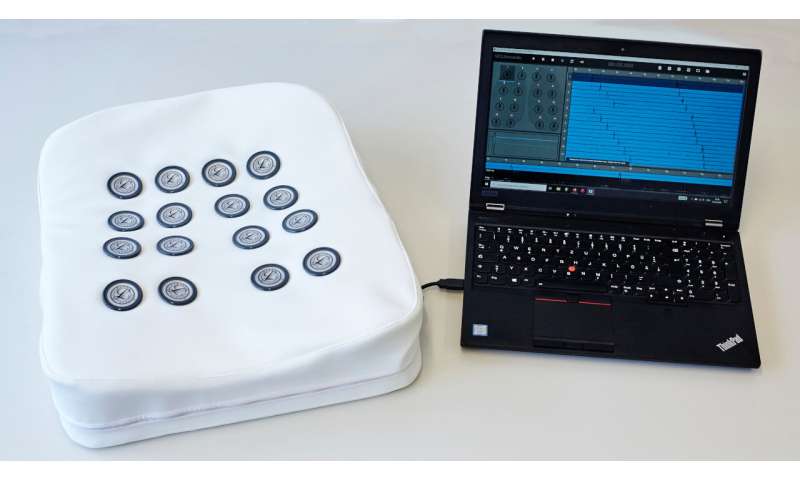Screening system for lung sound analysis

A multi-channel recording device developed at TU Graz for pathological lung sounds and associated automatic lung sound analysis could support existing screening methods for early detection of, for example, COVID-19 infections. This now requires clinical data and interdisciplinary collaboration.
They whistle, hiss and crackle. Our bodies constantly make sounds that (fortunately) are not always audible to the naked ear. The occurrence of certain noises or changes in normal sounds can be an indication of illness. Using the example of the lung, a research team at Graz University of Technology has been intensively engaged in noise recording and the development of computer-aided analysis methods as a supplement to medical diagnosis. A few months ago, the work culminated in a prototype of a multi-channel recording device and the ongoing development of an associated computer-aided diagnostic system. The group led by Franz Pernkopf from the Institute of Signal Processing and Speech Communication now wants to further develop the system for screening COVID-19 patients. For this purpose, sound recordings of COVID-19-positive persons in clinical treatment are needed. The Austrian Science Fund (FWF) is currently reviewing an application for urgent funding of a SARS-CoV-2 call.
Objective sound assessment as a diagnostic aid
Acoustic abnormalities in the lungs are often difficult to distinguish from normal lung sounds and other body sounds such as heart and bowel sounds, speech or coughing. The short-duration sounds have a relatively low amplitude and are in the low frequency range, where the human ear has limited sensitivity and is susceptible to sonic artifacts. Listening to the lungs with a stethoscope, the traditional way, has disadvantages. The assessment of lung sounds is subjective and varies according to the experience of the medical staff. Continuous monitoring is not possible with stethoscopes—whether real or digital.
The prototype developed at TU Graz, on the other hand, allows high-quality recordings of lung sounds, on the basis of which lung diseases and pathological lung conditions can be assessed more objectively. This enables clearer examination results and thus better treatments. Pernkopf explains the technology behind it: “The lung sound recording system (LSRS) is multi-channel and equipped with very powerful micro-electromechanical microphones (MEMS). The recording of lung sounds is non-invasive; the patient simply lies on the device in the supine position.” The device records the lung sounds during breathing using a total of 16 channels. The attenuation or damping of ambient and other body sounds and the quality of the recorded lung signals is crucial.
Data collection for automatic diagnosis
The LSRS records lung sounds at high quality which are further exploited for computer-aided automatic lung sound analysis. This requires a lot of data from which the system can learn. A clinical study is to help obtain correspondingly large data sets of healthy and pathological lung recordings. “Our primary focus is on the pulmonary sounds associated with pneumonia, bronchitis, pleurisy, idiopathic pulmonary fibrosis and systolic heart failure,” says Pernkopf. “For this, we need lung sound recordings of people of all genders, different age groups and with different body mass indexes.” A clinical study in collaboration with the Medical and Pharmaceutical University in Ho Chi Min City is currently being prepared for data collection. A preliminary study on sounds associated with idiopathic pulmonary fibrosis has already been conducted in cooperation with the Medical University of Graz (Freyja Smolle-Jüttner, Clinical Department of Thoracic and Hyperbaric Surgery and Horst Olschewski, Clinical Department of Pulmonology).
Adaptation of the system to COVID-19 typical lung sounds requires appropriate recording facilities for infected persons. “We are not tied to records of lung sounds from Vietnam, of course. However, it is a question of cost as to how quickly we can move forward here. We are therefore very much hoping for funds from the FWF funding pot and are confident that we will be able to offer our cost-effective screening approach for lung diseases—including those related to COVID-19 diseases,” says Pernkopf.
Supplementary tool in pre-screening
Source: Read Full Article
